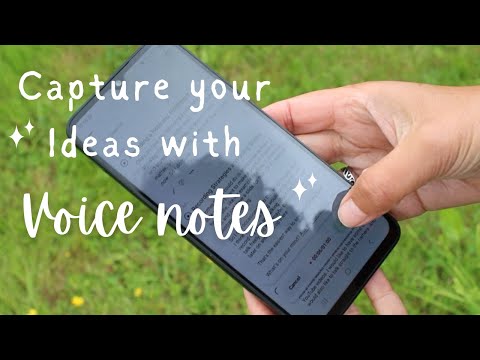How to Use Voice Notes for Ideas
You generate ideas at random times. You may not sit at your desk when these ideas appear. Voice notes help you save your thoughts fast. You record your idea with one tap. You do not pause your activity. This simple tool supports busy routines. Many creators use voice notes for clear thinking and content planning. Tech Food Trip highlights how quick recording helps people capture thoughts before they forget them.
Why Voice Notes Work for Idea Building
Voice notes work because they remove delay. You speak your idea in real time. You do not type or organize first. You save the raw thought so you can review it later. Your ideas stay safe. You avoid losing useful details. You also reduce pressure to write perfect notes during busy moments.
When you use voice notes, you create a small habit. You record consistently. You build a collection of ideas that support your personal and work projects.
How to Create a Simple Voice Note Setup
You need a clear structure. This keeps your ideas easy to review.
• Create one folder for ideas.
• Add sub folders for categories like work, personal tasks, home projects, or content topics.
• Use short labels for each folder.
• Use your phone’s default voice note app. It gives you fast access.
Your system should be simple. You should reach it with two taps. This helps you record ideas before they fade.
Record Ideas in Real Time
Ideas appear during travel, cooking, cleaning, or breaks. You should record them as soon as they form. Speak in clear sentences. Mention the main point first. Add two or three supporting details. Short recordings are easier to review. Aim for notes between ten and thirty seconds.
Speak Naturally
You do not need complete sentences. You can pause. You can speak casually. Your goal is to save the idea. You can refine it later. This method helps you capture more ideas in a day without pressure.
Use Tags for Fast Sorting
Tags help you find your ideas quickly. Use simple tags like tasks, home, shopping, routine, content, or project. Speak the tag at the start of the recording. Example: “Content idea. Tips for morning routines.” Your device will save the tag in your file name if the app supports transcription.
Turn Voice Notes into Written Lists
At the end of the day or week, review your voice notes. Convert them into a written list. You can group similar ideas. This builds a clear plan. This step helps you see which ideas deserve action. Food Travel Library often shares planning routines that involve daily review, which helps you keep your ideas active.
• Move strong ideas to a task list.
• Mark repeated ideas.
• Remove notes that no longer feel useful.
This keeps your ideal bank clean and easy to use.
Use Transcription to Speed Up Reviewing
Many phones offer built-in transcription. Enable this feature if available. Your spoken words convert into text. You save time during review. You can scan your ideas instead of listening to each recording. This helps you reorganize your thoughts faster.
Transcription also helps when you collect ideas for longer writing tasks. You copy your text into notes or documents without typing each line.
Organize Your Ideas by Purpose
You should organize your ideas into sections that match your needs.
• Daily tasks
• Work projects
• Home projects
• Content ideas
• Personal goals
This structure helps you use your voice notes as a planning tool. You can turn them into weekly or monthly plans. Organized ideas reduce stress and increase clarity in your day.
Use Voice Notes for Creative Thinking
Voice notes help you express ideas more freely. You speak without editing. This increases creative flow. Many people think better out loud. You can brainstorm topics, describe solutions, or plan small steps. You can explore your thoughts without a strict structure.
Using your voice also helps you remember details that you may skip when writing.
Combine Voice Notes with Timed Reviews
Set a fixed time each week to review your recordings. This keeps your ideas fresh and actionable. A ten minute review is enough. You avoid large backlogs. You turn your notes into clean plans.
This method supports long term thinking. You make steady progress on projects because you keep your ideas organized.
Use Voice Notes for Home Improvement Ideas
You can use voice notes while walking around your home. You can record small repairs, décor ideas, layout changes, or cleaning tasks. You save time and avoid forgetting important points.
Example ideas to record:
• Paint colors you like.
• Rooms that need new storage.
• Items that need maintenance.
• Items you want to replace.
This simple system strengthens your home planning routine.
Use Voice Notes for Shopping and Budget Planning
You can record items you need while checking your kitchen or bathroom. You update your shopping list in seconds. You can also record price comparisons or budget reminders.
This builds a living list that updates itself through your daily routine.
Use Voice Notes to Track Your Progress
You can track your growth by recording weekly reflections. You can speak about what you achieved and what needs work. This helps you understand your progress. You stay consistent with your goals.
Short reflection recordings give you clarity on what to adjust next.
Turn Voice Notes into Action Steps
Your idea becomes useful when you act on it. After reviewing your notes, choose one task to complete first. Break it into smaller steps. Add it to your planner or digital task app.
This system converts your spoken ideas into daily actions.
Keep Your System Simple
Your voice note system should feel easy. If you add too many folders or rules, you may stop using it. Keep your setup basic. Use your phone’s quick record feature. Review your notes at the same time each week. This helps you build a stable routine.
Use Voice Notes with Other Tools
You can pair voice notes with:
• Calendar apps
• To do apps
• Home planning sheets
• Budget trackers
This increases structure in your day. You move ideas from voice to action without wasting time.
Why This Method Helps You Think Better
You save time when you use your voice. You move faster than typing. You reduce mental load because you store ideas instead of keeping them in your memory. Research shows that quick capture improves productivity because you clear space in your mind for focused thinking.
Wise Plans often shares similar methods in productivity guides that encourage people to collect ideas in smaller steps to support long term planning.
Final Thoughts
Voice notes give you a simple way to record ideas that appear throughout your day. You save thoughts before they fade. You organize them into clear lists. You create a system that supports home tasks, work projects, and creative planning. Voice notes help you think better and stay organized with less effort. Tech Food Trip, Food Travel Library, and Wise Plans highlight similar recording habits that help people manage information without stress.




